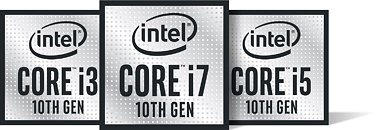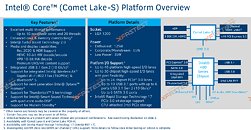Friday, August 23rd 2019

Alleged Leaked Details on Intel Comet Lake-S Platform Require... You Guessed It... A New Platform
Intel's development of their Core architecture in the post-Ryzen world has been slow, with solutions slowly creeping up in core counts with every new CPU release - but much slowly than rival AMD's efforts. Before Intel can capitalize on a new, more scalable and power-efficient architecture, though, it has to deliver performance and core count increases across its product line to stay as relevant as possible against a much revitalized rival. Enter Comet Lake-S: the desktop parts of Intel's new round of consumer CPUs, which will reportedly see an increase in the maximum core count to a 10-core design. This 10-core design, however, comes with an increase in power consumption (up to 135 W), and the need, once again, for beefier power delivery systems in a new, LGA 1200 package (with 9 more pins that the current LGA 1151).
The move to a new socket and the more stringent power requirements give Intel the opportunity to refresh its chipset offerings once again. If everything stays the same (and there's no reason it should change), new Z470 and Z490 chipsets should be some of the higher tier offerings for builders to pair with their motherboards. The new Comet Lake-S CPUs will still be built in the now extremely refined 14 nm process, and allegedly keep the same 16 PCIe 3.0 lanes as current Coffee Lake Refresh offerings. The new CPU offerings from Intel are expected to roll out in Q1 2020.
Sources:
XFastest, via Tom's Hardware
The move to a new socket and the more stringent power requirements give Intel the opportunity to refresh its chipset offerings once again. If everything stays the same (and there's no reason it should change), new Z470 and Z490 chipsets should be some of the higher tier offerings for builders to pair with their motherboards. The new Comet Lake-S CPUs will still be built in the now extremely refined 14 nm process, and allegedly keep the same 16 PCIe 3.0 lanes as current Coffee Lake Refresh offerings. The new CPU offerings from Intel are expected to roll out in Q1 2020.


224 Comments on Alleged Leaked Details on Intel Comet Lake-S Platform Require... You Guessed It... A New Platform
we knew the 9900k is 95W and eats > 170W when overclocking
so this 10 core will eat 240W ?
Intel is really cheating us here. I'm not really pissed about the fact that it's still PCIe Gen 3 but more pissed about the limited number of lanes especially when AMD offers 24 of them. Again... What the hell Intel?!?!
10nm is:
1 - A manufacturing process
2 - Specced out by Intel
3 - Developed by Intel in Intel labs
4 - To make Intel hardware at Intel facilities using Intel-designed equipment.
Intel are are the only party responsible for their 10nm processes success or failure.
In comparison, PCI-E is:
1 - A specification
2 - Specced out by PCI-SIG
3 - Developed with their partners across the entire computing industry, in their facilities, using collaborative expertise
4 - To make industry-standard hardware at the facilities of anyone who wants to make that hardware.
There are over 900 companies in PCI-SIG and when that many businesses are involved, and rely on, the correct engineering of an upcoming standard, you can bet your ass that none of them are going to let a specification or a standard out of the door that they aren't able to practically guarantee will actually work and can actually be built.
10 cores with 16 PCI_E lanes. Dare i say whelmed :)
The fun part will be next year when cheap PCIe 4.0 x2 SSD models will be offering the speeds of more expensive PCIe 3.0 x4 models.
Been ready for a while now, other companies already using it since a year back, only Intel dragging their asses.
Intel just thought they where safe from competition so why hurry developing cpus with PCIe 4.0, now they are paying for it.
anyway they are still awesome cpus but they cost a lot more than AMD
My point was that Intel controls when 10nm is ready. They screwed up by announcing it long before they were ready to ship it, and they got hurt by that.
But Intel doesn't control when PCI-E 5.0 is ready. PCI-SIG does that. And if Intel announces (or leaks) that they're going to implement PCI-E 5.0 in future, then that means they (and PCI-SIG) are both sure that PCI-E 5.0 will be ready to go at that time.
Why am I sure of that? Because there are 900 other companies all involved in the decision making here, and the announcement of PCI-E 5.0 being ready to go, would have only happened after those 900 companies all agreed that PCI-E 5.0 was ready to launch and could be delivered on time.
Their are Gpus and Ssds that can use pciex4 and owners who want to use it too.
Intel just sent those customers elsewhere for two years.
Would you, @theoneandonlymrk, please like to explain to me, exactly how juiseman's point is true, bearing in mind that:
1 - designing a controller to implement an existing standard is nowhere near as complicated as building a new semiconductor manufacturing process from scratch
2 - PCI-SIG doesn't release standards that aren't ready to be implemented, whereas Intel *did* announce a 10nm technology that was nowhere near implementation.